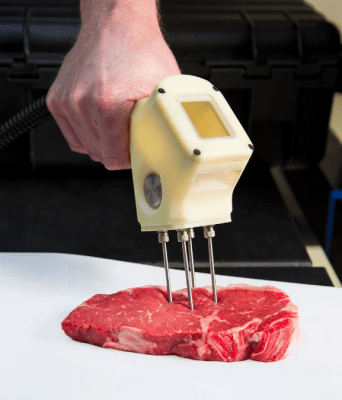HOW often is agri research commercialised in Australia? It’s not every month, probably not even every year. One could be forgiven for thinking it sits on the spectrum of time somewhere between peace in the Middle East and the return-to-earth orbit of Halley’s comet.
Whatever it is, industry and tax payers have been force feeding this fatty ‘service’ sector thinking ‘wtf’ for too long. But more on that later.
It’s reassuring to hear that we’ve just witnessed the commercialisation of a research project that’s resulted in a very impressive agtech startup. What is it? Well, when you cross cancer-measuring laser technology with an intelligent research body, an agri focused entrepreneur, a wee bit of funding and a commercialisation firm; you get a device that can be taken to market to measure marbling and tenderness in a freshly cut beef carcase. Cool hey!?
From the outside it seems the slow and overweight research sector finally popped one out! But scratch the surface and you’ll find a smart, outcome focused team who worked hard, collaborated and were in the right place at the right time.
The South Australian based agtech startup, MEQ Probe, has been born from medtech (medical technology) and suggests it is a potential game changer for the red meat industry, as the medical grade laser probes measures eating quality in real-time; measurements that are typically taken manually and more subjectively by the human eye. And what’s more, producers will be able to access the individual animal data through an MEQ Probe platform.
 The laser probe (pictured right) was originally developed by the University of Adelaide’s Centre for Nanoscale BioPhotonics (CNBP) to measure the pH of cancerous and non-cancerous tissue in humans. MEQ Probe pivoted the technology, applying it to the food sector by building specialised software, hardware and algorithms for which it now owns all the IP for after they spun it out of CNBP. I caught up with CEO Jordy Kitschke who said:
The laser probe (pictured right) was originally developed by the University of Adelaide’s Centre for Nanoscale BioPhotonics (CNBP) to measure the pH of cancerous and non-cancerous tissue in humans. MEQ Probe pivoted the technology, applying it to the food sector by building specialised software, hardware and algorithms for which it now owns all the IP for after they spun it out of CNBP. I caught up with CEO Jordy Kitschke who said:
“We’ve been working with researchers the whole time and I guess it’s been a culture change for them in terms of thinking of everything in the eyes of the industry, so looking at it with the commercial lens of ‘how can I build something that someone can pick up and use and make money from’?
“We’ve brought everyone along for the journey, taking the researchers out of the labs and putting them in a paddock or an abattoir and getting them to understand the setting that we need to provide things in,” he said.
Jordy also said the team made sure there was an industry partner to work with at major steps along the way so they remained solution-focused.
I’m blown away by these people (far smarter than I) who find innovative solutions in places you’d never think to look. And agtech will continue to see more tech from other sectors being repurposed into solutions for agriculture. Our industry is a wonderful testing and commercialisation ground for medtech in particular; agriculture has very little regulation compared to the medical industry, and it’s much easier access to industry players and quicker access to trials.
MEQ Probe worked with CNBP and Availer, a commercialisation organisation in South Australia which was given seed funding from the SA government ($2.5million) to fund 14 startups. MEQ Probe was one of them. But the amazing thing about MEQ Probe for me, isn’t the technology, or the pivoting of a medtech product into agtech. It’s the fact it was an Australian research project that has been nurtured (in Australia) into a fundable and scalable startup. Sounds simple, and it should be, but it’s far from it.
Call for ‘strategic vision’
It comes at a time when a Minister for Agriculture has finally cast a spotlight on an expensive, inefficient and ineffective system that’s supposed to be an ‘innovation ecosystem’.
David Littleproud has commissioned Ernst & Young to develop “a strategic vision” for Australia’s rural innovation system which will investigate the research sector.
 I hit-up a man with a tonne of grit who has long been suggesting a review into the wastage of funds across the sector, The Hon Shadow Minister for Agriculture Joel Fitzgibbon.
I hit-up a man with a tonne of grit who has long been suggesting a review into the wastage of funds across the sector, The Hon Shadow Minister for Agriculture Joel Fitzgibbon.
“Minister Littleproud has now followed my lead by announcing he will conduct a review of our research and innovation effort. I welcome his announcement, but it is not yet clear what he has in mind. If his review does not include an examination of the architecture and efficiency of our RDCs, it will fall short,” Mr Fitzgibbon told me.
It’s time. Given there are much cheaper, faster and more effective ways to innovate and create social and economic impact, let’s hope the review and recommendation captures a 21st century approach and is more effective in implementation than the white papers and other window dressings we get served up.
If a new system isn’t designed to create more MEQ Probes, which increase efficiency and drive greater returns back into the farm gate, then what’s the point?
About Sam Trethewey
 Sam Trethewey is from a farming family and has worked across Australia and overseas on most major commodities including beef, wool, lamb and cropping. He co-founded SproutX, Australia’s first and largest agtech accelerator and investment fund where he spent nearly three years developing an ecosystem of support for agtech startups. He has been a regular commentator on agriculture through print, radio and online and has recently started his own food production company whilst also working as Head of Brand for Redhanded, a rural and regional communications specialist.
Sam Trethewey is from a farming family and has worked across Australia and overseas on most major commodities including beef, wool, lamb and cropping. He co-founded SproutX, Australia’s first and largest agtech accelerator and investment fund where he spent nearly three years developing an ecosystem of support for agtech startups. He has been a regular commentator on agriculture through print, radio and online and has recently started his own food production company whilst also working as Head of Brand for Redhanded, a rural and regional communications specialist.
Questions? If you’ve got an agtech topic you’d like Sam to tackle, please email [email protected]


Interesting it is not the only technology which has been developed and taken up and the MEQ is yet to demonstrate it can do what it says and provide robust predictions.